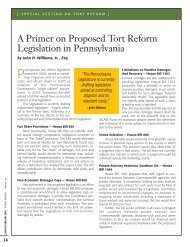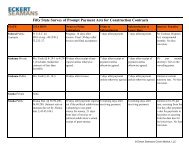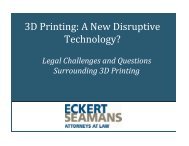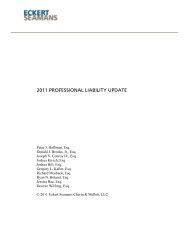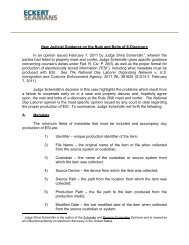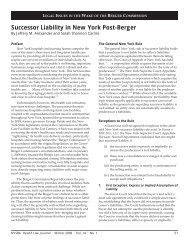MCARE also changes the manner in which judgments, including future medicalexpenses, are paid. Under the statute, future medical expenses will be paid quarterly based uponthe present value of the expenses awarded with adjustments for inflation and the life expectancyof the plaintiff. 40 P.S. § 1303.509(b)(1)-(2). These periodic payments will terminate upon thedeath of the plaintiff. 40 P.S. § 1303.509(b)(5). Each party liable for all or a portion of the futuredamages shall contribute funding to the awarded periodic payments by means of an annuitycontract, trust, or other court-approved funding plan. 40 P.S. § 1303.509(b)(6). An award forfuture medical expenses is paid in a lump sum where the plaintiff stipulates that the expenses,without present value reduction, do not exceed $100,000. 40 P.S. § 1303.505(b)(8).(e)Preservation and Accuracy of Medical RecordsIn another effort to protect the safety of patients, MCARE requires that all entries into apatient’s chart must be made simultaneously with the rendering of the treatment to bedocumented, or as soon after as practically possible. 40 P.S. § 1303.511(a). Subsequent,additional, and/or reversionary entries into the patient’s chart must be clearly identified with thedate and time of their entry. 40 P.S. § 1303.511(b)(2)(i)-(ii).Additionally, MCARE addresses the consequence of an intentional alteration ordestruction of a patient’s medical records. 40 P.S. § 1303.511(c). The license of a medicalprofessional who engages is such prohibited activity is subject to suspension or revocation. 40P.S. § 1303.511(d). Furthermore, if a plaintiff can prove an intentional alteration or destructionof a medical record or entry, a jury may be instructed that such alteration and/or destructionconstitutes a negative inference. 40 P.S. § 1303.505(c).This issue was also addressed by the Philadelphia County Court of Common Pleas inBugieda v. Hosp. of the Univ. of Pennsylvania, 2007 Phila. Ct. Com. Pl. LEXIS 36 (C.P. Phila.Feb. 6, 2007). In this case, the defendant hospital argued that, pursuant to the MCARE Act, 40Pa. Cons. Stat. § 1303.511(c), a claimant must prove by a preponderance of the evidence thatthere was an intentional alteration or destruction of medical records before the jury is instructedon adverse inference due to lack of medical records produced. The Court rejected this argumentand held that there was no indication that the MCARE charge was intended to replace the chargegiven in medical malpractice actions as noted by the Superior Court in Magette v. Goodman, 771A.2d 775 (Pa. Super. Ct. 2001), appeal denied, 790 A.2d 1017 (Pa. 2001). The Court reasonedthat the general rule regarding adverse inference in medical malpractice actions applies when aparty fails to produce the records that would be in its interest to produce and does not necessarilydepend on the destruction or alteration of medical records.(f)Expert QualificationsIn order to be qualified to give expert medical testimony at a medical malpractice trial,the proposed expert must possess sufficient education, training, knowledge and experience toprovide credible, competent testimony. 40 P.S. § 1303.512 (a); see, e.g., Wexler v. Hecht, 928A.2d 973 (Pa. 2007). Additionally, MCARE establishes additional standards for qualification ofan expert in a medical liability case. 40 P.S. § 1303.512. Under the Act, in order to qualify as anexpert, a physician must possess an unrestricted medical license in any state (including theDistrict of Columbia), and have been engaged in active clinical practice or teaching within the100
previous five years. 40 P.S. § 1303.512(b)(1)-(2). The expert must also be familiar with theapplicable standards for the care at issue, and the expert must have practical experience in thesame subspecialty as the defendant physician, or be board-certified by the same or similarapproved board as the defendant doctor. 40 P.S. § 1303.512(c).The court may waive the subspecialty requirement for an expert if the defendantphysician provided care for a condition not within the defendant physician’s specialty. Undersuch circumstances, the court will certify a proposed expert where that proposed expert is trainedin the treatment of the condition for which the defendant physician actually treated (where suchcondition is outside of the specialty of the defendant doctor). 40 P.S. § 1303.512(d)However, many of these qualifications may be waived if the Court finds that the expertotherwise “possesses sufficient training, experience and knowledge to provide the testimony as aresult of active involvement in or full time teaching of medicine in the applicable subspecialty,”thus leaving the competency of the witness largely within the discretion of the trial judge. 40P.S. § 1303.512.(g)Statute of ReposeFor causes of action arising on or after March 20, 2002, a seven-year statute of reposewill apply. 40 P.S. § 1303.513. This provision will bar the commencement of a lawsuitasserting medical malpractice more than seven years from the date of the alleged tort or breachof contract. 40 P.S. § 1303.513(a). The Statute of Repose affects the influence of the “discoveryrule.” The “discovery rule” tolls the two-year statute of limitations for personal injuries until thepatient becomes aware of the alleged tort, or reasonably should have become aware of thealleged tort. Prior to the enactment of MCARE, the discovery rule was available to delay theexpiration of the statute of limitations for many years under certain circumstances. However,MCARE now limits the amount of time that the discovery rule can toll the statute of limitationsby requiring that suits be brought with seven years despite a possibly later deadline previouslyavailable under the discovery rule.It is worth noting that MCARE’s Statute of Repose does not apply to situations whereforeign objects are unintentionally left in the patient’s body, or for affirmative misrepresentationor fraudulent concealment of the cause of death in wrongful death or survival actions. 40 P.S. §1303.513 (c). Furthermore, minors may commence a lawsuit alleging a tort or breach of contractwithin the seven years under the Statute of Repose, or until their 20th birthday, whichever islater. 40 P.S. § 1303.513(c).Wrongful death and survival actions 10 must be commenced within two years afterthe death in the absence of affirmative misrepresentation or fraudulent concealment of thecause of death. 40 P.S. § 1303.513(d). In a recent case, Matharu v. Muir, 29 A.3d 375 (Pa.Super. June 28, 2011), the court found that the statutes of limitations delineated by 40 P.S.§ 1303.513(d) trumped more general statutes of limitations that preceded MCARE. InMatharu, defendants brought wrongful death and survival claims on behalf of their son,10 I.e., claims brought under under 42 Pa.C.S. § 8301 (relating to death action) or 8302 (relating tosurvival action).101
- Page 3 and 4:
EMTALA CASES ......................
- Page 5:
Filing an Affidavit of Non-Involvem
- Page 8 and 9:
II.PROFESSIONAL LIABILITY - AN OVER
- Page 10 and 11:
The Superior Court reversed the tri
- Page 12 and 13:
to a third party pursuant to the st
- Page 14 and 15:
After approximately five months, De
- Page 16 and 17:
learned the day after the surgery t
- Page 18 and 19:
conduct to the delay in colon cance
- Page 20 and 21:
court admitted the expert’s testi
- Page 22 and 23:
(b)(c)other reasonable causes, incl
- Page 24 and 25:
corroborated his testimony. The cou
- Page 26 and 27:
husband’s estate. Plaintiff alleg
- Page 28 and 29:
Other notable federal cases arising
- Page 30 and 31:
The Superior Court found that in re
- Page 32 and 33:
§ 1303.512(b). The court, however,
- Page 34 and 35:
In Neidig v. United States, No. 07-
- Page 36 and 37:
Additionally, the Supreme Court not
- Page 38 and 39:
were not indicated for her conditio
- Page 40 and 41:
surgeon is the same as it would be
- Page 42 and 43:
It should be noted that the Superio
- Page 44 and 45:
Finally, the court held that the tr
- Page 46 and 47:
The Supreme Court of Pennsylvania r
- Page 48 and 49:
nurses deviating from applicable st
- Page 50 and 51:
certainty, the court reviews expert
- Page 52 and 53:
Under Pennsylvania law, the Court n
- Page 54 and 55:
testimony, Defendant presented his
- Page 56 and 57: Following Cooper v. Roberts, 286 A.
- Page 58 and 59: Plaintiff developed chronic diarrhe
- Page 60 and 61: where payment is made by Medicaid w
- Page 62 and 63: accomplished. In Valles v. Albert E
- Page 64 and 65: In 1980, the Pennsylvania Superior
- Page 66 and 67: Plaintiff had a routine monitoring
- Page 68 and 69: Plaintiff’s Contract ClaimsThe Co
- Page 70 and 71: is a failure to report changes in a
- Page 72 and 73: unit to assure post-surgical patien
- Page 74 and 75: sliced his wrist and arm with a raz
- Page 76 and 77: licensed professionals for whom the
- Page 78 and 79: (c)Limitations of Corporate Neglige
- Page 80 and 81: Even more recently, our Superior Co
- Page 82 and 83: (a)HMO IssuesIn McClellan v. Health
- Page 84 and 85: affidavit submitted by Defendants o
- Page 86 and 87: treatments while at VA’s faciliti
- Page 88 and 89: [s]ubstantively, we believe that a
- Page 90 and 91: The party claiming the benefit of t
- Page 92 and 93: deprive (him) of civil rights guara
- Page 94 and 95: found that the District Court was w
- Page 96 and 97: With respect to fraudulent concealm
- Page 98 and 99: would be applied in situations wher
- Page 100 and 101: they had not raised them in the cou
- Page 102 and 103: (a)Informed ConsentUnder MCARE, a p
- Page 104 and 105: civil enforcement provisions and ma
- Page 108 and 109: whose death, in 2005, was allegedly
- Page 110 and 111: vicariously liable if the plaintiff
- Page 112 and 113: health center or its equivalent or
- Page 114 and 115: In Pennsylvania Medical Society, th
- Page 116 and 117: to any professional who is alleged
- Page 118 and 119: Since the 2005 amendments, there ha
- Page 120 and 121: ule, but who intentionally ignores
- Page 122 and 123: the original Complaint was delivere
- Page 124 and 125: foreclose all challenges against th
- Page 126 and 127: number of boxes), which was support
- Page 128 and 129: questions of professional judgment
- Page 130 and 131: deviated from any professional stan
- Page 132 and 133: The Third Circuit affirmed the Dist
- Page 134 and 135: claims and cross-claims remain agai
- Page 136 and 137: By an Amendatory Order dated March
- Page 138 and 139: The court acknowledged that there i
- Page 140 and 141: apply and that the trial court misa
- Page 142 and 143: Barbados had enough litigation-spec
- Page 144 and 145: E. Preemption of Vaccine Design Def
- Page 146 and 147: 2. Pa. R. Civ. Pro. 1036.1 - Reinst
- Page 148 and 149: Barrick, at *34-35.Furthermore, the
- Page 150 and 151: (b) the utility of the defendant’
- Page 152 and 153: 2006). In this case, Plaintiffs bro
- Page 154 and 155: B. Elements of a Cause of Action fo
- Page 156 and 157:
decision in Muhammad precluded Mr.
- Page 158 and 159:
considered speculative “only if t
- Page 160 and 161:
underlying cause of action involved
- Page 162 and 163:
In Capital Care Corp., the Superior
- Page 164 and 165:
The court found, however, to state
- Page 166 and 167:
of reasonable diligence. The standa
- Page 168 and 169:
not be set aside. On July 7, 2005,
- Page 170 and 171:
complete bar to recovery. Since a l
- Page 172 and 173:
On appeal, Plaintiffs claimed that
- Page 174 and 175:
In Liggon-Redding, 659 F.3d at 265,
- Page 176 and 177:
elieved of those minimum standards
- Page 178 and 179:
elevant to the proceedings, the com
- Page 180 and 181:
establish professional misconduct b
- Page 182 and 183:
Upholding the Superior Court’s Or
- Page 184 and 185:
Id.Rejecting revocation and suspens
- Page 186 and 187:
order as a sanction under Rule 4019
- Page 188:
{1009912]182




